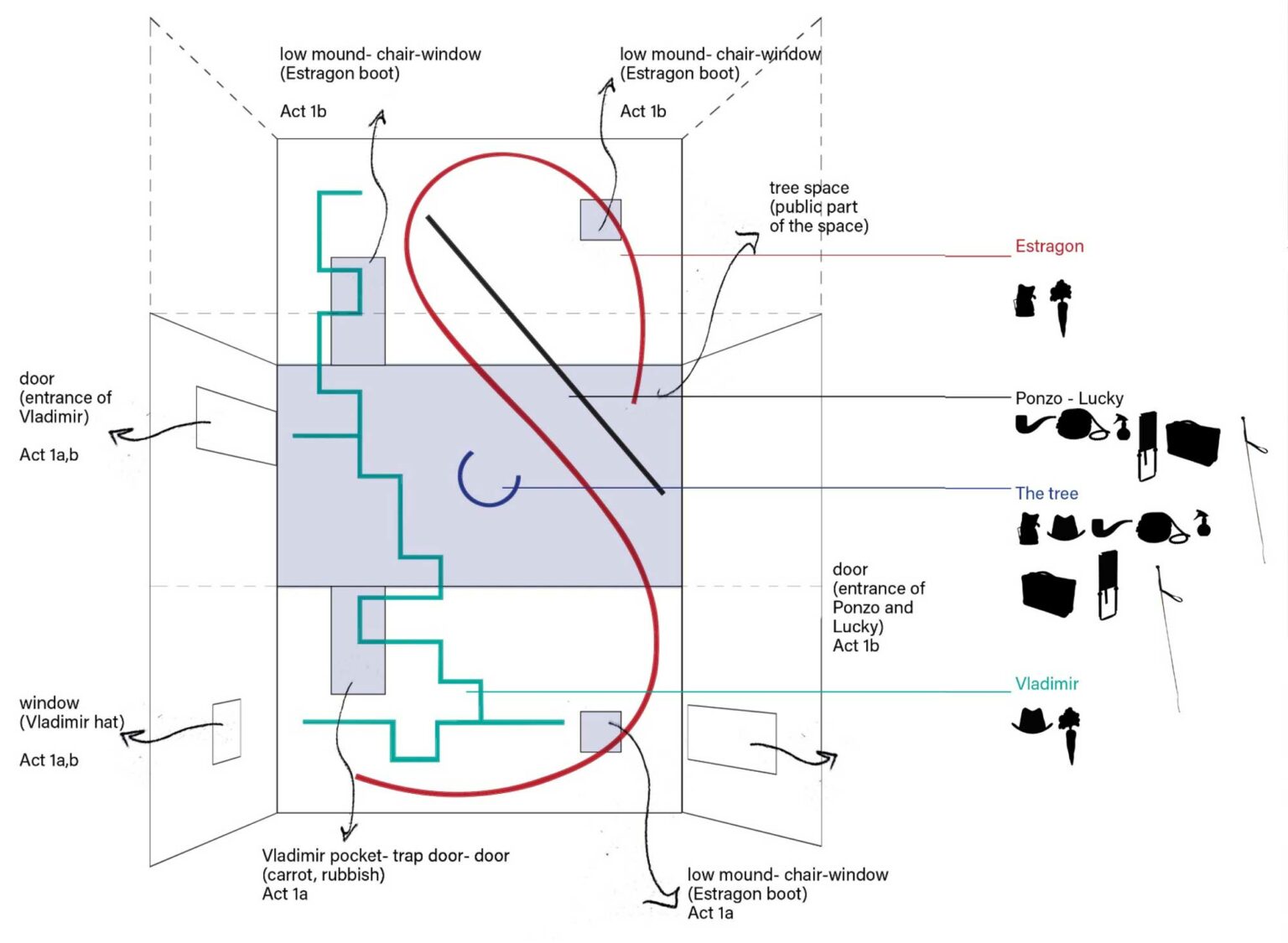Kyriaki Forti

I am a multi-disciplinary spatial designer with a keen interest in scenography, concept, and exhibition design. I hold an integrated master’s degree in architecture from Technical University of Crete, and I have completed courses in theatre performance, set and costume design at the National Theater of Greece. Utilising my architecture and design background in my practice, I aim to shape a holistic approach to performance spaces in an attempt to create immersive and site-specific narratives. My projects in GSA span between the exploration of the relationship between audience and stage and the speculative design of narratives using a limited selection of objects to infuse new meaning into their existing forms.

Waiting for Godot at Tramway-Thesis Project
In this project, using Samuel Beckett’s theatre play «Waiting for Godot», I have tried to frame how I interpret the idea of a contemporary theatre experience and highlight the importance of continually expanding the limits of theatre typology. Exploring the relationship between audience and stage and the concept of doing the most with the least on set design process, this project seeks to challenge the conventional meanings assigned to objects within the play.
The story follows Estragon and Vladimir, who are trapped in the same location, spending their entire lives waiting for the arrival of Godot. They are trying to make the time pass by finding ways to interact with each other and the objects that surround them. Even though their movements and the relationship with the objects in the play is very detailed, I had the sense of random incidents that happen in repeat, so each day is almost the same as the previous one and will be the same with the day after. That makes me question what is of the most importance, the objects or the rituals created by the objects within the play. And if I give these objects new meanings, how can this openness to different interpretations give me the freedom to imagine different objects, different interactions with the objects and different spaces.
My intention is to re envision the most ubiquitous theatre typology of our era: the black box – a vessel for illusions, where the concealed backstage area remains hidden from the audience’s view. I began contemplating the prospect of revealing all the concealed components inherent to theatre design. These elements are commonly seen as a way to challenge the illusionist nature of theatre, thereby crafting a typology that functions as a mechanism for generating illusions.
Project Links



enter Ponzo and Lucky

ACT 1 - TYPOLOGY

THE SUNDIAL

act-2-entrance



final scene

ACT 2 TYPOLOGY

The light switch


characters vladimir and estragon

characterS ponzo- lucky

How rituals shape space


paths audience engagement
Lady from the sea – Host Project
This project is the output of my second-semester project, which involved identifying and visualizing the ‘Host’ for a utilitarian site that stands aloof from its environment. My proposal is for an immersive art event at the Minerva Street Victorian public toilets, which aims to transform this opaque structure into a cohesive space that can tell a story.
ABOUT THE EVENT…
The event “Spend a Penny” is a fictional co-production of the Edinburgh Festival Fringe and the Glasgow Cultural Association, with the aim of reviving Scotland’s public toilets and transforming them into art spaces.
The show “Lady from the Sea” is not an ordinary production. You can purchase the publication of the play as you buy your ticket. Note that the experience will not be the same if you do not read it beforehand.
The event is divided into two parts. Before the start of the performance, you have one hour to meet the characters of the play, touch their personal belongings, and listen to the sounds of their subconscious. You are free to move around the space and leave as many times as you wish. During the show, please remain in the designated stage area and help the actors with your attitude. Remember you are part of the play.
Please note that the event contains nudity. We apologize for any inconvenience this may cause.
Project Links


ACT 1. Sailor’s Wife is Sleeping

ACT 3. Sea Creatures


spatial elements
Creative Publishing in the Arts
This publication is based on Henrik Ibsen’s theater play “The Lady from the Sea”. The reason for this publication, which is correlated with my second-semester design project “Host,” is to explore new ways of spatially representing a story. I see a book as an empty vessel ready to tell a story, and I want to find connections between theater, performance, and book publishing.
My aim is to understand how a book could be a useful tool, a host for telling the same story, and communicating an idea spatially in a more abstract way. At the same time, I want to introduce a different type of reader, the audience reader. I was inspired by the Fluxus art movement and, more specifically, by George Brecht, who is a pioneer of an art that depends entirely on the viewer. His artworks become an “event” when the viewer accepts the “invitation” to interact with them. I attempt to integrate this interaction in my publication by giving the reader the chance to phrase the story and be part of the narration in an active way. The entire publication is a passage from the classic way of reading a book to the way I anticipate the role of publication and its connection with theater and spatial design. To do so, I start exploring the public and private word of the book and, at the same time, the dual nature of text in publication, text as an object, and text as a signifier. Another key element in my publication is the use of small books, objects, music, and narratives hosted inside the main book.
























